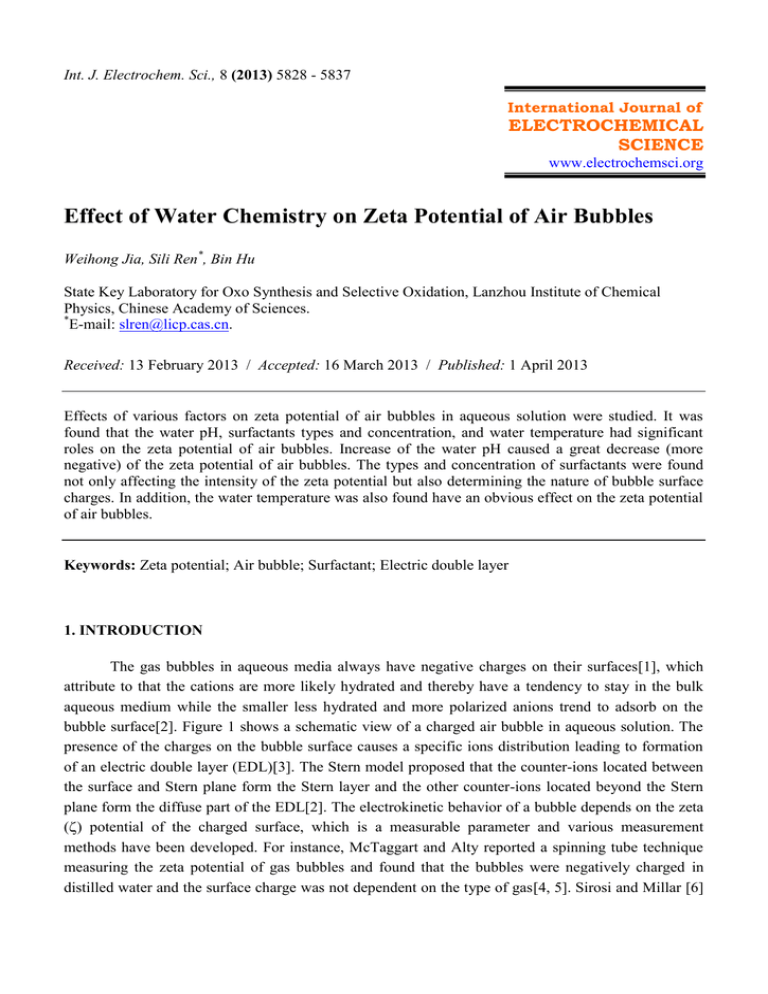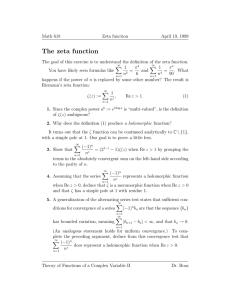Effect of Water Chemistry on Zeta Potential of Air Bubbles
advertisement

Int. J. Electrochem. Sci., 8 (2013) 5828 - 5837 International Journal of ELECTROCHEMICAL SCIENCE www.electrochemsci.org Effect of Water Chemistry on Zeta Potential of Air Bubbles Weihong Jia, Sili Ren*, Bin Hu State Key Laboratory for Oxo Synthesis and Selective Oxidation, Lanzhou Institute of Chemical Physics, Chinese Academy of Sciences. * E-mail: slren@licp.cas.cn. Received: 13 February 2013 / Accepted: 16 March 2013 / Published: 1 April 2013 Effects of various factors on zeta potential of air bubbles in aqueous solution were studied. It was found that the water pH, surfactants types and concentration, and water temperature had significant roles on the zeta potential of air bubbles. Increase of the water pH caused a great decrease (more negative) of the zeta potential of air bubbles. The types and concentration of surfactants were found not only affecting the intensity of the zeta potential but also determining the nature of bubble surface charges. In addition, the water temperature was also found have an obvious effect on the zeta potential of air bubbles. Keywords: Zeta potential; Air bubble; Surfactant; Electric double layer 1. INTRODUCTION The gas bubbles in aqueous media always have negative charges on their surfaces[1], which attribute to that the cations are more likely hydrated and thereby have a tendency to stay in the bulk aqueous medium while the smaller less hydrated and more polarized anions trend to adsorb on the bubble surface[2]. Figure 1 shows a schematic view of a charged air bubble in aqueous solution. The presence of the charges on the bubble surface causes a specific ions distribution leading to formation of an electric double layer (EDL)[3]. The Stern model proposed that the counter-ions located between the surface and Stern plane form the Stern layer and the other counter-ions located beyond the Stern plane form the diffuse part of the EDL[2]. The electrokinetic behavior of a bubble depends on the zeta () potential of the charged surface, which is a measurable parameter and various measurement methods have been developed. For instance, McTaggart and Alty reported a spinning tube technique measuring the zeta potential of gas bubbles and found that the bubbles were negatively charged in distilled water and the surface charge was not dependent on the type of gas[4, 5]. Sirosi and Millar [6] Int. J. Electrochem. Sci., Vol. 8, 2013 5829 measured the zeta potential of gas bubbles based on the horizontal electrophoresis of a rising bubble. It was realized that the reliability of the zeta potential results was influenced by the measured electrophoretic transverse deviation of the rising bubble, which was attributed to that the cell used was too large and restricted the measurements. Then Collins et al.[7] reduced the cell dimension to a millimeter order of magnitude. However, the bubble size was still so large that the bubbles rose too fast to be tracked visually. As a result, inconsistent results were often obtained because of the short tracking time. Usui and Sasaki[8] employed an approach utilizing the Dorn effect to evaluate the zeta potential. It was found that the zeta potential of gas bubbles depended strongly on the bubble size. Dibbs et al[9] used a method based on the streaming current technique, which was essentially the same as the Dorn potential technique. Most of the efforts showed that the zeta potential of gas bubbles in aqueous solution is negative over a wide pH range (3-11) [10, 11]. Figure 1. Schematic view of the charged air bubble in aqueous solution. The presence of the charges on the bubble surface causes a specific ions distribution leading to formation of an electric double layer. The zeta potential of air bubbles plays a significant role in bubble-solid, bubble-oil droplet attachment and bubble coalescence. Therefore it is a significant factor affecting some important industrial processes, such as the mineral flotation, oil sands separation, waste and potable water treatment, etc[12-14]. Especially, in oil sands processing using the water-based extraction processes (WBEPs), the liberated bitumen droplets need to attach an air bubble and float to form the bitumen froth[15]. The bitumen-bubble attachment is influenced by the zeta potential of air bubbles, which thereby affects the bitumen recovery and froth quality. Chun Yang[1] investigated the effects of solution pH and electrolyte on the bubble zeta potential. The results indicated that the bubbles are basically negatively charged in an univalent solution (NaCl). It was further found that the presence of multivalent mental ions such as Ca2+ and Al3+ could greatly change the magnitude of the bubble zeta potential and even reverse the bubble’s charge polarity. Najafi et. al [16] developed a new method to produce well dispersed “nano-bubbles” and measured the zeta potential of gas bubbles under various Int. J. Electrochem. Sci., Vol. 8, 2013 5830 conditions. It was confirmed that various surfactants including the natural surfactants in the oil sands processing water had a pronounced effect on the electrokinetic of air bubbles. From the above it can be seen that studies of the electrokinetic behaviors of bubbles in various aqueous solutions have a far-reaching significance and is always an attraction to the researchers. Investigation on effects of various factors on the zeta potential of air bubbles in aqueous solution was therefore the motivation of this work. It was showed that the water pH, the added surfactants type and concentration, and water temperature had important effects on the zeta potential of air bubbles. The results gave an useful guidance to the control of the water chemistry for some important industrial floatation processes, especially for the oil sands processing. 2. EXPERIMENTAL Preparations of Air Bubbles and Zeta potential Measurments. The method used to produce air bubbles was according to the literature[16] . In brief, the aqueous solutions were air-saturated at a low temperature of about 4 ºC by purging air for 2 hours. The air-saturated solutions were then kept in a refrigerator under 4 ºC. The zeta potential measurements were performed by using a ZetaPALS instrument (Brookhaven Instruments Co., New York). During the zeta-potential measurements, the air-saturated solutions were rapidly heated up to 25 ºC using the temperature adjustment circuit installed inside the ZetaPALS. Due to the elevated temperature, the air bubbles were generated and thus the zeta-potential of air bubbles was measured. Formation of bubbles in the solutions was demonstrated by the Tyndall effect. An obvious laser beam could be observed after temperature rising, while no laser beam occurred when the solutions were kept at low temperature [16]. An electric field was applied to the cell and the electrophoretic mobility of the generated air bubbles was measured by periodic analysis of light scattering technique. The zeta potential of the air bubbles was calculated through the relationship between the electrophoretic mobility (μ) and zeta potential (ζ)[17]: μ = ζ ε η f(ka) Where ε is the dielectric constant; η is the viscosity; and the factor f(ka) is of the order unity. The zeta potential is an average of five measurements under the same solution conditions. To study the effect of surfactants on the zeta potentials of bubbles, Dodecyl trimethyl ammonium chloride (DTAC) as a cationic surfactant and sodium 1-dodecanesulfonate (SDS) as an anionic surfactant were added in the water solution. They are both analytical purity. On processing oil sands using WBEPs technique, natural surfactants are always released from bitumen to the aqueous solution. To study the effect of the natural surfactants on the zeta potential of bubbles without interference from other factors, the water solution only containing the natural surfactants from bitumen was prepared. A 2.0 g sample of bitumen was first placed in a beaker, and Int. J. Electrochem. Sci., Vol. 8, 2013 5831 then 200 mL of ultra-pure water was added. The pH of the water solution was adjusted to about 10.5 using NaOH. The releasing process was conducted at elevated temperature of 60 ºC and under discontinuous ultrasonic condition for 48h. After finishing the releasing process, the mixture of water and insoluble bitumen was filtered. As a result, water solution containing the natural surfactants was thereby obtained. The purpose of preparing the natural surfactants included water solution in such a way is to avoid the interference to the zeta potential of air bubbles from other factors, such as various electrolytes or other surfactants added during the bitumen extraction processes. Ultra-pure water with a resistivity of 18.25 MΩcm was used throughout the experiment. 3. RESULTS AND DISCUSSION 3.1 Effect of the water pH on Zeta Potential of Air Bubbles It has been extensively reported that the zeta potentials of most colloidal particles in the aqueous solution were greatly affected by the water pH and tended to decrease (more negative) with increasing the pH value[11, 18-20]. For example, the zeta potential of bitumen emulsion significantly decreased from about 0 mV to -80 mV as the pH increased from 3 to 10[21]. The effect of water pH on zeta potential of the air bubble is shown in Figure 2. Figure 2. Effect of pH and various surfactants on zeta potentials of air bubbles in aqueous solution. It is expectedly observed that the zeta potentials of the air bubble considerably decreased with increasing the water pH for the three situations (1 mM KCl; 100 ppm SDS + 1 mM KCl; and 100 ppm DTAC + 1 mM KCl). Taking the air bubbles in 1mM KCl solution as an example, the zeta potential is about -5.8 mV at pH=6.5. At such a pH value, concentration of the OH¯ is equivalent to that of H+. However, the positive ions (H+) preferentially remain in the bulk aqueous phase leaving space at the air-liquid interface for negative ions, which is called “negative adsorption” or “protons exclusion”. As Int. J. Electrochem. Sci., Vol. 8, 2013 5832 a result, the surface of air bubble at pH=6.5 is negatively charged and give a zeta potential about -5.8 mV. As the pH value decreased, the concentration of OH¯ exponentially reduced. Instead, the H+ concentration greatly increased and its adsorption on the air-water interface will significantly decreasing the negative charges density and even reversing the charge. Resultantly, the zeta potential of air bubble exhibited a positive value of about 1.6 mV in 1 mM KCl solution at pH=3.5. As the pH of the solution increased to 10.5, the concentration of OH¯ exponentially increased. Its strong adsorption on the bubble surface will greatly increase the negative charges density and then considerably decreased the zeta potential to about -21.2 mV. These results indicate that the pH of the aqueous solution should be well considered on performing a floatation process. 3.2 Effect of Surfactants Addition on Zeta Potential of the Air Bubbles It is well known that the surfactants generally include both hydrophilic and hydrophobic parts in a molecule, which make the surfactants easily adsorb on the air-water interface. It is therefore expected that the surfactants addition in aqueous solution will play a significant role on the zeta potential of the air bubbles. Most industrial flotation processes, such as oil sands separation, waste water treatment and the mineral flotation, need surfactants addition. Effects of the surfactants on zeta potential of air bubbles at different pH were thereby studied and the results are also shown in Figure 2. It can be seen that the surfactants addition greatly affected the zeta potential of air bubbles and especially different types of surfactants have very distinct effect. The anionic surfactant of sodium 1dodecanesulfonate (SDS) greatly decreased (more negative) the zeta potential of air bubble, while the cationic surfactant of dodecyltrimethyl ammonium chloride (DTAC) made it more positive and even reversed the charge polarity. Such results are attributed to the ionization and adsorption of the surfactants on the air-water interface, leading to the change of EDL structure, which are illustrated in Figure 3. Because the hydrophilic polar group tended to stay in the water phase and the hydrophobic tail tended to toward in the air phase, the surface charges of air bubbles in surfactant solution are thereby strongly dependent on the type of added surfactant. As the result, it was expectedly found that the anionic surfactant of SDS greatly decreased the zeta potential of air bubbles at various pH values because of the increase of the negative charges density at the bubble surface by the SDS adsorption. In contrast, the cationic surfactant of DTAC will considerably decrease the negative charges density at the bubble surface and even reverse the charge polarity from negative to positive. Therefore, due to the addition of DTAC, the zeta potential of the air bubble increased (tending to positive) and even got positive value of 18.5 mV at pH=3.5 and 1.9 mV at pH=6.5. These results indicate that the anionic surfactants addition in the water solution will make the zeta potential of bubble more negative. For an industrial floatation process, if the particles needed to attach a bubble to be floated also have negative charged, the anionic surfactants addition will be disadvantage to the floatation process because of the electrostatic repulsive force between the particles and bubbles. Int. J. Electrochem. Sci., Vol. 8, 2013 5833 Figure 3. A schematic view of the various surfactant molecules adsorbing on the air-water interface: (a) The adsorption of SDS on the air-water interface greatly decreased (more negative) the zeta potential of air bubble. (b) The cationic surfactant DTAC made it more positive and even reversed the charge. Bitumen extraction from oil sands using WBEPs technique is generally conducted in an alkaline environment[22]. At such condition, organic acids in the bitumen are ionized to produce surfactants, which are the active species for bitumen liberation and aeration. Effect of the natural surfactants derived from bitumen on zeta potential of air bubbles was studied at pH 10.5 and the result was also shown in Figure 2 for a comparison with other situations. It should be pointed out that the concentration of the released natural surfactants in the water solution was not determined in this work. Nevertheless, the variation trend of the zeta potential of air bubbles can still be clearly reflected as shown in Figure 2. It was found that the air bubbles in the water solution containing the natural surfactants have a zeta potential of about -33mV, which is lower than that in 1 mM KCl solution and higher than that in 100 ppm SDS solution. Such result indicated that the active species released in the water solution from bitumen are anionic surfactants. It is believed that the produced surfactants are generally caboxylates or sulfates/sulphomates[15]. Like the effect of SDS on the zeta potential of air bubbles, the presence of produced natural surfactants increased the negative charges density at the bubble surface and thus decreased the zeta potential of air bubbles. Najafi et. al [16] measured the Int. J. Electrochem. Sci., Vol. 8, 2013 5834 electrophoretic mobility of gas bubbles in the plant oil sands processing water, in which various electrolytes or other surfactants were always added during the bitumen extraction processes. In this work, preparation of the natural surfactants-included water solution by “dissolving” the bitumen in the ultra-pure water in an alkaline condition could well avoid the interference to the zeta potential of air bubbles from other factors, such as the various electrolytes and added surfactants. It is well known that the bitumen surface is generally negative charged in the water solution[21]. Therefore, with respect to the attachment of air bubble on the bitumen droplets, the released natural active species in the slurry is disadvantaged to the bitumen aeration. 3.3 Effect of Concentration of the Surfactants on the Zeta potential of Air Bubbles Figure 4 shows the effect of concentration of the surfactants on zeta potential of air bubbles. It is obvious that the surfactant concentration has a great effect on the zeta potential of the bubble. In DTAC solution, the zeta potential gradually increased from -4.4 mV to 12.6 mV as the DTAC concentration increased from 10ppm to 200ppm. With a same increase of the concentration of SDS, the zeta potential greatly decreased from -32.9 mV to -64.1 mV. Such results are expected and can be well understood considering that the adsorption of surfactant molecules on bubble surface will be enhanced as increasing the concentration of the surfactants, which result in the increase of the charge density at the bubble surface. Figure 4. Effect of concentration of the surfactants on the zeta potentials of air bubbles at pH=6.5. 3.4 Effect of Temperature on the Zeta potential of Air Bubbles In industry, some floatation processes need to be performed in elevated temperature. Therefore, the effect of temperature on the zeta potential of air bubbles is crucial to some industrial flotation processes. The effect of temperature on the zeta potential of air bubbles was examined in background solution of 100 ppm SDS solution at pH=10.5 and 100 ppm DTAC at pH=3.5. As shown in Figure 5, it Int. J. Electrochem. Sci., Vol. 8, 2013 5835 is interesting to observe that the zeta potential of air bubbles increased for the SDS situation and decreased for the DTAC situation when temperature went up from 10°C to 70°C. In other words, the zeta potentials of bubbles for both situations tend to approach zero with increasing the solution temperature. For example, the zeta potential increased from about -52mV at 10°C to -2.9mV at 70°C for the air bubbles in SDS solution at pH=10.5, while it decreased from about 54mV at 10°C to 3mV at 70°C for the air bubbles in DTAC solution at pH=3.5. It is well known that the temperature is an important factor affecting the stability of the solution system. It is expected that the mobility of the ionized surfactant molecules in the solution will be enhanced at elevated temperature environment, which might decrease the adsorption of surfactant molecules on the bubble surface and then result in the reduce of the surface charge density. As a result, the zeta potential of the air bubbles decreased and approached to zero with increasing the solution temperature. Another most possible reason is that the enhanced brownian motion of the air bubbles at high temperature counteracts the electrophoretic mobility, which results in a false zeta potential. Therefore, the factor of temperature must be considered when the zeta potential was measured and compared with others. Figure 5. Effect of the water temperature on Zeta potential of air bubbles in SDS solution at pH=10.5 and in DTAC solution at pH=3.5. 4 CONCLUSION The zeta potential of air bubbles in aqueous solution was measured by using a microelectrophoresis technique. We systematically studied the effects of various factors on the zeta potential of air bubbles in aqueous solution. The experimental results showed that the water pH, the surfactants types and concentration, and the water temperature had significant roles on the zeta potential of air bubbles. Increase of the water pH caused a great decrease (more negative) of the zeta potential of air bubbles, which was attributed to the variation of the concentration of OH¯ ions in the Int. J. Electrochem. Sci., Vol. 8, 2013 5836 solution. The types and concentration of surfactants were found not only affecting the intensity of the zeta potential but also determining the nature of charges on the bubble surface. Within our knowledge, the effect of solution temperature on zeta potential of bubble has not been reported yet. It was found that the solution temperature had a great effect on the zeta potential. Therefore, the factor of temperature must be considered when the zeta potential was measured and compared with others. The studies of the effects of various factors on the zeta potential of air bubbles in aqueous solution have a great potential application in many practical fields. It may contribute to the oil sands processing, de-inking in paper-recycle pulp, de-oiling in heavy-oil exploration, toxic effluent treatment in chemical and mining industry, and fine solids removal in industrial and domestic water treatment[16, 23]. Significantly, the findings in this work give an in-depth understanding of the floatation process in bitumen extraction from oil sands, and hence give an useful guidance for better control of the bitumen extraction process. ACKNOWLEDGEMENTS The authors acknowledge the financial support from the National Natural Science Foundation of China (Grant No. 50904060) and the “100 Talents Program” held by the Chinese Academy of Science (CAS). References 1. C. Yang, T. Dabros, D. Li, J. Czarnecki and J.H. Masliyah, J Colloid Interface Sci 243 (2001) 128 2. D.J. Shaw, Introduction to colloid and surface chemistry. Butterworths, London, 1980 3. R.J. Hunter, Zeta potential in colloid science: principles and applications. Academic press, London, 1981 4. H.A. McTaggart, Philosophical Magazine Series 6 44 (1922) 386 5. G.L. Collins, M. Motarjemi and G.J. Jameson, J Colloid Interface Sci 63 (1978) 69 6. J. Dutrizac, Journal of the Less Common Metals 31 (1973) 281 7. L. Sirois and G. Millar, Canadian Metallurgical Quarterly 12 (1973) 281 8. S. Usui and H. Sasaki, J Colloid Interface Sci 65 (1978) 36 9. H. Dibbs, L. Sirois and R. Bredin, Canadian Metallurgical Quarterly 13 (1974) 395 10. R. Sanders, R. Chow and J. Masliyah, J Colloid Interface Sci 174 (1995) 230 11. C. Yang, T. Dabros, D. Li, J. Czarnecki and J.H. Masliyah, AIChE journal 49 (2003) 1024 12. Y. Fukui and S. Yuu, Chemical Engineering Science 35 (1980) 1097 13. K. Kubota and G. Jameson, Journal of chemical engineering of Japan 26 (1993) 7 14. C. Yang. Attachment of fine gas bubbles onto a solid surface and electrokinetics of gas bubbles, University of Alberta, 2000 15. J. Masliyah, Z.J. Zhou, Z. Xu, J. Czarnecki and H. Hamza, The Canadian Journal of Chemical Engineering 82 (2004) 628 16. A.S. Najafi, J. Drelich, A. Yeung, Z. Xu and J. Masliyah, J Colloid Interface Sci 308 (2007) 344 17. L. Kuznetsova,and H. KOVARSKII, Colloid journal of the Russian Academy of Sciences 57 (1995) 657 18. J.Y. Kim, M.G. Song and J.D. Kim, J Colloid Interface Sci 223 (2000) 285 19. M. Takahashi, The Journal of Physical Chemistry B 109 (2005) 21858 20. P. Creux, J. Lachaise, A. Graciaa, J.K. Beattie and A.M. Djerdjev, The Journal of Physical Chemistry B 113 (2009) 14146 Int. J. Electrochem. Sci., Vol. 8, 2013 5837 21. J. Liu, Z. Zhou, Z. Xu and J. Masliyah, J Colloid Interface Sci 252 (2002) 409 22. S. Wang, J. Liu, L. Zhang, Z. Xu and J. Masliyah, Energy & Fuels 23 (2008) 862 23. W. Wang, Z. Zhou, K. Nandakumar, Z. Xu and J.H. Masliyah, International journal of mineral processing 68 (2003) 47 © 2013 by ESG (www.electrochemsci.org)





